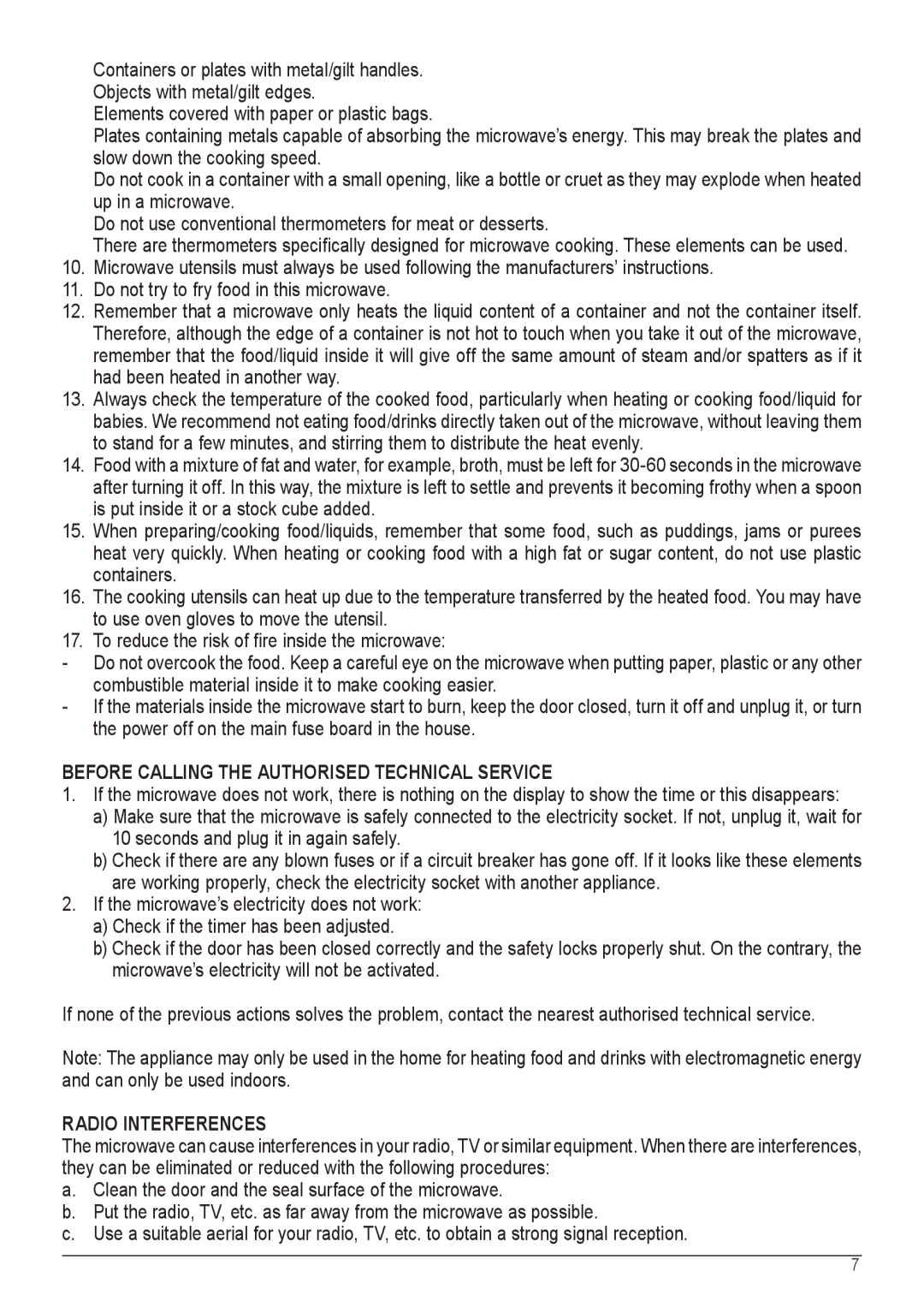Containers or plates with metal/gilt handles. Objects with metal/gilt edges.
Elements covered with paper or plastic bags.
Plates containing metals capable of absorbing the microwave’s energy. This may break the plates and slow down the cooking speed.
Do not cook in a container with a small opening, like a bottle or cruet as they may explode when heated up in a microwave.
Do not use conventional thermometers for meat or desserts.
There are thermometers specifically designed for microwave cooking. These elements can be used.
10.Microwave utensils must always be used following the manufacturers’ instructions.
11.Do not try to fry food in this microwave.
12.Remember that a microwave only heats the liquid content of a container and not the container itself. Therefore, although the edge of a container is not hot to touch when you take it out of the microwave, remember that the food/liquid inside it will give off the same amount of steam and/or spatters as if it had been heated in another way.
13.Always check the temperature of the cooked food, particularly when heating or cooking food/liquid for babies. We recommend not eating food/drinks directly taken out of the microwave, without leaving them to stand for a few minutes, and stirring them to distribute the heat evenly.
14.Food with a mixture of fat and water, for example, broth, must be left for
15.When preparing/cooking food/liquids, remember that some food, such as puddings, jams or purees heat very quickly. When heating or cooking food with a high fat or sugar content, do not use plastic containers.
16.The cooking utensils can heat up due to the temperature transferred by the heated food. You may have to use oven gloves to move the utensil.
17.To reduce the risk of fire inside the microwave:
-Do not overcook the food. Keep a careful eye on the microwave when putting paper, plastic or any other combustible material inside it to make cooking easier.
-If the materials inside the microwave start to burn, keep the door closed, turn it off and unplug it, or turn the power off on the main fuse board in the house.
BEFORE CALLING THE AUTHORISED TECHNICAL SERVICE
1.If the microwave does not work, there is nothing on the display to show the time or this disappears:
a)Make sure that the microwave is safely connected to the electricity socket. If not, unplug it, wait for 10 seconds and plug it in again safely.
b)Check if there are any blown fuses or if a circuit breaker has gone off. If it looks like these elements are working properly, check the electricity socket with another appliance.
2.If the microwave’s electricity does not work:
a)Check if the timer has been adjusted.
b)Check if the door has been closed correctly and the safety locks properly shut. On the contrary, the microwave’s electricity will not be activated.
If none of the previous actions solves the problem, contact the nearest authorised technical service.
Note: The appliance may only be used in the home for heating food and drinks with electromagnetic energy and can only be used indoors.
RADIO INTERFERENCES
The microwave can cause interferences in your radio, TV or similar equipment. When there are interferences, they can be eliminated or reduced with the following procedures:
a.Clean the door and the seal surface of the microwave.
b.Put the radio, TV, etc. as far away from the microwave as possible.
c.Use a suitable aerial for your radio, TV, etc. to obtain a strong signal reception.
